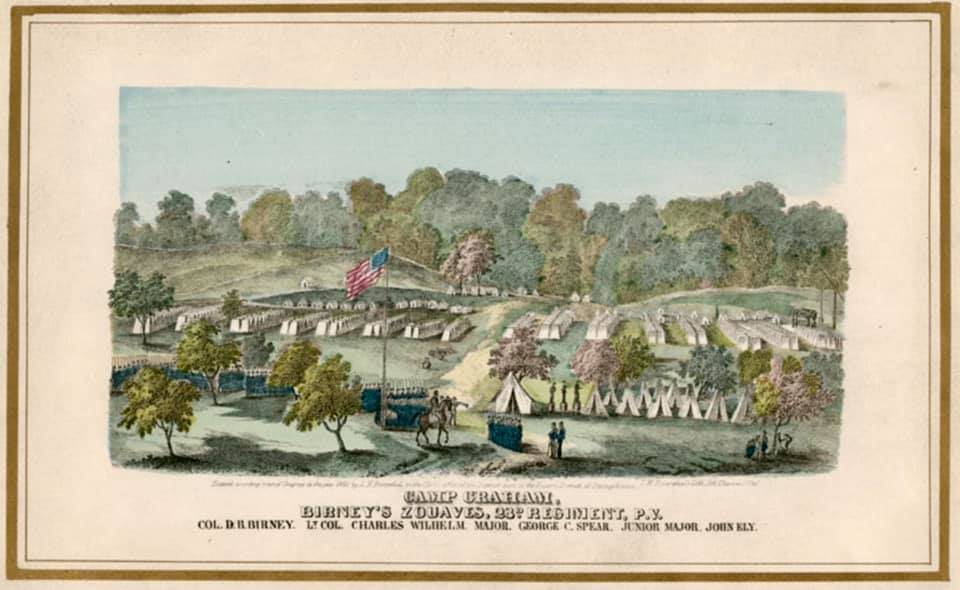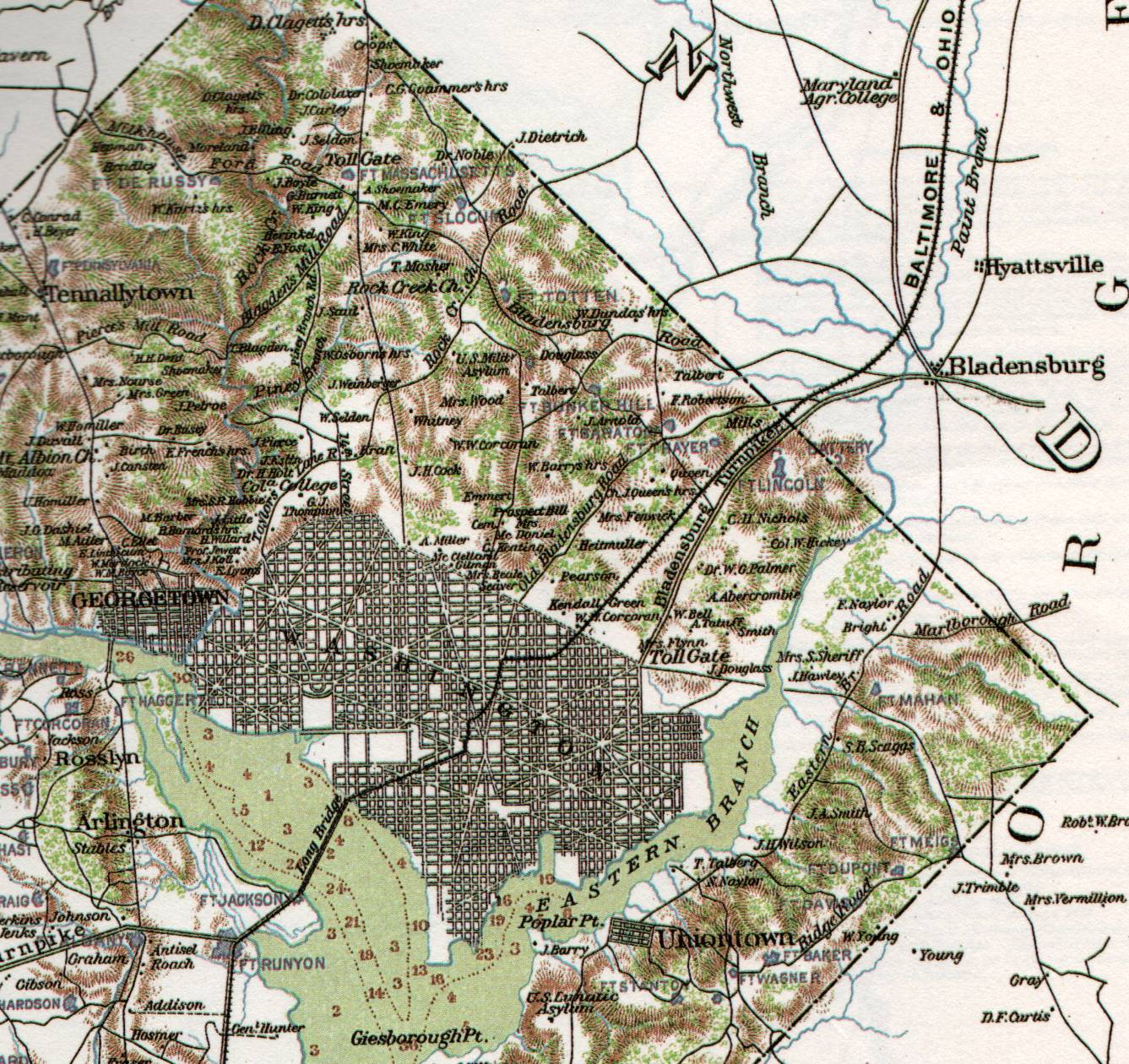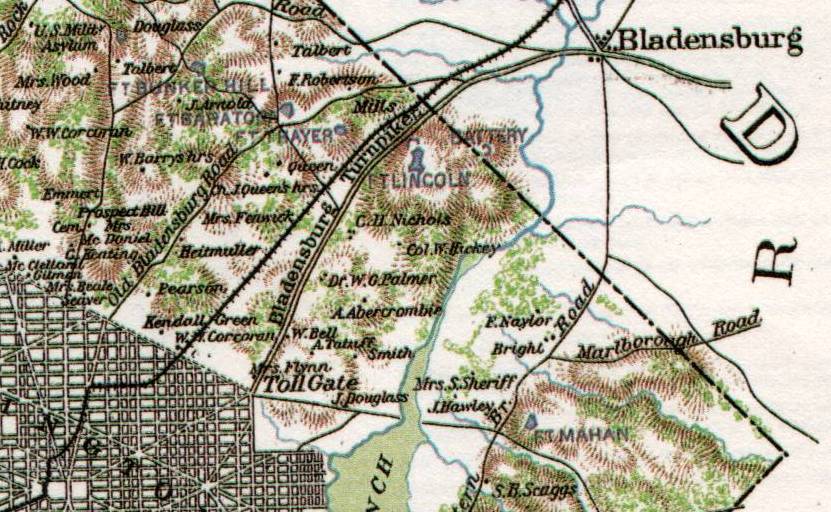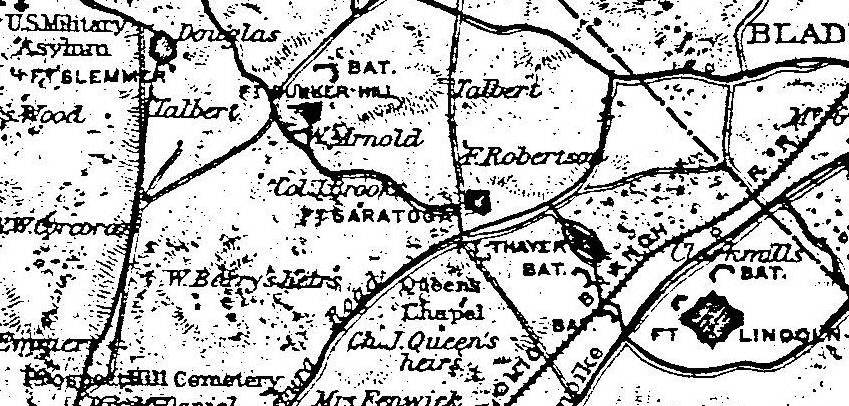 
Home Obituaries Burial Records Traveling Artifacts Newspaper Clippings Soldier Cards Census Recordas Gymnast Zouaves Timeline Death Certificates |
”Camp Graham” Queen’s Farm , Washington, DCOn September the 8th 1861 they moved the camp, and renamed it ”Camp Graham", about three miles north of Washington, to the Queens Farm on the Seventh Street Road, somewhere near the Soldiers Home. The Queen Farm appears to have been in the vicinity of the present day intersection of Puerto Rico Ave. and Taylor Street, NE, in the Michigan Park neighborhood. This area is quite close to the U.S. Soldiers' and Airmen's home, and roughly a mile from Georgia Ave. (formerly the 7th Street Pike). At the time of the Civil War, the area was part of Washington County, D.C., not the city.

Camp Graham (Washington D.C.

Washington D.C. 1861
The farm was in the vicinity of several forts and Batteries, including Fort Totten and Fort Slocum. The Queen family owned several large plots of land in the vicinity, Queen's Chapel Rd. in nearby Prince George's County, MD still bears their name. The camp was situated on fairly high ground with a bird’s eye view of the Capital and “Arlington Heights”. It was in an open field that was surrounded by trees, but victim to the elements. During the hot months, soldiers were subject to the extreme heat and there was but a few trees to shade them.

Closeup of the Area of the 23rd PA Camps
During wet weather the Camp was very muddy and in the winter the men were subject to high winds and extreme cold. Here the authority of the War Department recruited the regiment to fifteen companies. During the month of October the men of the 23rd were sent out to cut down about twenty acres of wood and many of the men gathered Chestnuts, which were just about ripe. Just one week previous they were detached as the grand guard and were stationed one mile from the camp, on the Bladensburg Road. On November 8th the brigade including the 23rd were lined up about 12,000 men in a line. Each man was given 20 rounds of blank cartridge and was marched to an open field about a mile from Washington. General McClellan, President Lincoln and a number of other distinguished officers, which was made known by the firing of a salute, then reviewed them. Then the band struck up “Hail to the Chief”. After the review they were drilled all day and marched back to Camp. The Twenty third was assigned to the First Brigade, First Division, and Forth Corps. They were drilled in U.S. Infantry Tactics, Evolutions of the Line & McClellan’s bayonet exercises. General Graham was the schoolmaster teaching the officers every night from 7-9 pm. (Captains on Monday and Thursday, 1st Lt’s on Tuesday and Friday, 2nd Lt’s on Wednesdays and Saturdays.) Though there was plenty of drilling on a serious note the regiment did have a lot of enjoyment in camp. Some of the activities enjoyed were Baseball, Sack Races, Ox Roasting, Pig races, boxing, alcoholic beverages and Pole climbing and The Whirligig for prizes. Day by day the Regimental Band lifted the spirits of the men by playing patriotic songs in the Camp and during Dress parade and review. The men of the 23rd also built a theatre, which Captain Hildebrand approved of to occupy the men’s time during rainy weather and for their own personal entertainment. They were also taught to built fortifications, cutting timber and doing picket and guard duty. Forts Lincoln, Totten, Stevens, and Cedar Hill were witnesses of their workmanship and efforts. The 23rd received their State flag on December 14th 1861 with extensive preparations being made for the ceremony. The Camp was elaborately decorated with evergreens and an elegant dinner was provided. On December 15th 1861, Typhoid Fever prevailed upon the Camp due to its location and fifty men and one officer died.
”Camp Clark” , near Bladensburg, MDThe camp was moved to higher and airy ground on “Clark’s Farm” on February 10th 1862, somewhere near Bladensburg and the typhoid disappeared. However the muddy conditions continued in some placed the mud being eight inches deep. Here the regiment began live target practice from 200 yards. On February 17th Col. Birney was appointed a Brigadier General and the 23rd received a new Col. In Thomas O Neil. O Neil was commanded to detach four companies (L, O, P, and R) with Major Spear to the 61st PA Volunteers and to disband Company M, distributing them amongst the other ten Companies. This order was obeyed under protest with much reluctance. By March 3rd The Twenty Third PA had received marching orders and had to leave their tents and Camp behind.

Closeup of the Area of the 23rd PA Camps (Queen and Clark)
Losses
|
 
History 23rd PA Monument David Bell Birney Original Photos Uniform 23rd PA Flag Virtual Cemetery Pension Records Submit a Burial Monument Rededication Regimental History |
© October 26,2010 - "Birney's Zouaves" The 23rd PA Infantry Volunteers
Hosted by Angelfire